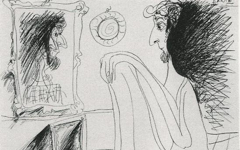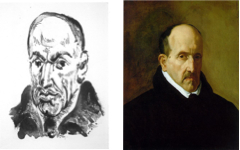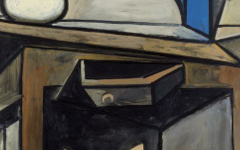Velazquez’s Portrait of Luis de Góngora (1622)...and Picasso’s.

Velazquez, Portrait of Luis de Góngora (1622) Oil on canvas. Museum of Fine Arts, Boston
Click image to enlarge.
Michelangelo's muse from the realm of literature was the great Florentine poet, Dante Alighieri, whose likeness Michelangelo used as the basis of his greatest masterpiece, The Last Judgment.1 Luis de Góngora (1561-1627), a half century later, was, in turn, one of Spain's greatest poets whom Diego Velazquez seems to have held in similar regard. Velazquez painted his portrait (left) early in his own career, a portrait of the man so remarkable that it seems to have inspired Manet, Cézanne and Picasso as well.
Click next thumbnail to continue

Left: Detail of Velazquez's Portrait of Luis de Góngora
Right: Diagram of Velazquez's Portrait of Luis de Góngora
Click image to enlarge.
The light in the portrait naturally shines onto Góngora's bald pate to emphasize the importance of his mind. Yet, what few - save those three artists - would have noticed would have been something so shocking to the high priests of the Spanish Inquisition, then in high gear, that the artist was risking his career. Velazquez shaped Góngora's bald spot on the left side into a naked and fully formed female breast, its nipple clearly indicated where two hairlines meet. The line of "her rib cage" then descends to his ear. Góngora's mind is thus the feminine source of Velazquez' own poetic fertility, an androgynous combination of archetypal power.
Click next thumbnail to continue
Picasso, for one, was clearly aware of Velazquez's visual illusion because when he came to illustrate a set of Góngora's poems in 1948, he also printed this portrait (left) which is obviously based on Velazquez's. However, as with Velazquez's metamorphosis, Picasso's is unseen as well. As far as I know, no-one has noted that Góngora did not have a thick black curl of hair in the center of his forehead. That is Picasso's addition. Why?
Click next thumbnail to continue

Left: Detail of Picasso's Portrait of Luis Góngora, rotated.
Right: Diagram of sleeping baby in detail at left.
Click image to enlarge.
In adding that mark Picasso delineated an infant's closed eye and thereby magically turned the poet's bald pate into the head of a sleeping baby. The poet's frown is the child's button nose. There are now two ways to view this print. You can either see a Picasso-like portrait of Góngora, his baldness radically altered by Picasso for no reason whatsoever or you can imagine (correctly) that Picasso has depicted the Spanish poet's mind as a dreaming child, pure and God-like. I leave it to you to decide which is more poetic - and thus more likely.
Notes:
1. See the Quick Guide to the Sistine Chapel to view Michelangelo's "portrait" of Dante.
Original Publication Date on EPPH: 04 May 2013. | Updated: 0. © Simon Abrahams. Articles on this site are the copyright of Simon Abrahams. To use copyrighted material in print or other media for purposes beyond 'fair use', you must obtain permission from the copyright owner. Websites may link to this page without permission (please do) but may not reproduce the material on their own site without crediting Simon Abrahams and EPPH.




